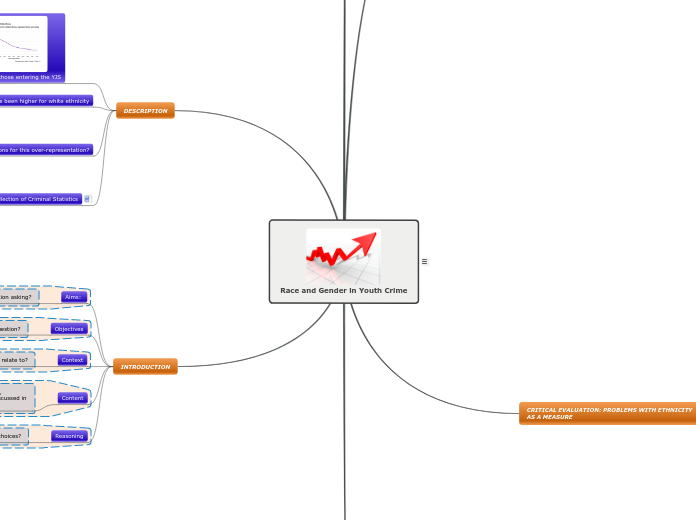What influences crime?
Classical Theory
Free Will Theory
Theorist: Cesare Beccaria
Crime is the result of free will.
Punishment must be just strong enough to deter: no Death Penalty.
Rational Choice Theory
Theorist: Cohen and Felson
Crime is the result of conscious choice.
The benefits outweigh the costs.
Hedonistic Calculus Theory
Theorist: Jerry Bentham
Crime will be avoided if the benefit is outmatched by the consequences.
Punishment must be 'swift and certain' to work.
Key Word = Deterrence
Liberal Theory
Sociological Theory
stress
Differential Opportunity Theory
Theorist: Cloward and Ohlin
Gangs form for economic opportunity.
x Criminal Gang
x Conflict Gang
x Retreatist Gang
Anomie Theory
Theorist: Emile Durkheim, Merton
A social crisis causes people to adopt criminal values.
Strain Theory
Theorist: Cohen, Cloward and Ohlin, Agnew, Messner and Rosenfeld
Social Structures in society may cause criminal behavior if they do not satisfy the needs of the people.
social class
Radical Crime Theory
Theorist: Turk, Void, Chambliss
A big gap between the rich and the poor results in crime. The rich control gov't and rules, and try to keep the poor down. (Cheap Crack Cocaine + Meth punishments.)
Middle Class Measuring Rod Theory
Theorist: Albert Cohen
Middle class has higher values, like respect, planning for the future, etc. If they don't think they can measure up to society, they do the opposite and get involved with crime.
Lower Class Focal Concern Theory
Theorist: Miller
Lower class has lower class concerns. Those desires lead to crime. (Tough 'reps', being street smart).
family/peers
Differential Association Theory
Theorist: Sutherland
Criminal methods and motives are learned from peers.
Criminal Family Theory
Theorist: Dugdale
If your family has a criminal history, you're likely to have one, too.
Social Learning Theory
Theorist: Burgess and Akers
Former offenders, who were led in by Differential Association, think about what happened in the past and decided if a crime is worth doing.
relationships
Labeling Theory
Theorist: Edwin Lemert
Secondary deviance explained only.
Once given a 'label' people will live up to it.
Social Control Theory
Theorist: Travis Hirschi
People don't commit crimes if they're bonded to society in a meaningful way.
Attachment to others,
Committment to a positive lifestyle,
Involvement in positive activity,
Belief in common values.
Those without are more likely to get involved in criminal activity.
Where you live
Broken Window Theory
Theorist: None in particular
Research done in the 1980's.
Graffiti-covered and run-down buildings leads to more graffiti and destruction due to a perceived vulnerability.
CPTED was created--Crime Prevention Through Environmental Design.
Chicago School Theory
Theorist: Shaw and McKay; Park and Burgess
Research done in the 1920's.
The enivironment shapes your behavior.
1.) The central business district (Businesses)
2.) Trasitional Zone (Factories)
3.) Working Class Zone (Cheap apartments)
4.) Residential Zone (Homes with yards + garages)
5.) Commuter Zone (Fancy houses/suburbs.)
1 is the worst, 5 the best.
The closer you are to the business district = more crime.
Biological Theory
Somatotypes Theory
Theorist: William Sheldon
People are of three body types: Ectomorphic, Mesomorphic, and Endomorphic. Most are a combination. Certain traits and criminal behaviors can be attributed to each type.
Physically, Endomorphs have:
x a soft body
x underdeveloped muscles
x round shaped features
x an over-developed digestive system
Mentally, Endomorphs:
x have a love of food
x are tolerant
x have evenness of emotions
x have a love of comfort
x are sociable
x are good humored
x are relaxed
x have a need for affection
Physically, Mesomorphs have:
x a hard, muscular body
x an overly mature appearance
x rectangular-shaped features
x thick skin
x upright posture
Mentally, Mesomorphs:
x are adventurous
x have a desire for power and dominance
x are courageous
x are indifferent to what others think or want
x are assertive and bold
x have a zest for physical activity
x are competitive
x have a love of risk and chance
Physically, Ectomorphs have:
x thin bodies
x a flat chest
x a delicate build
x a young appearance
x tall bodies
x lightly muscled bodies
x stoop-shouldered posture
x a large brain
Mentally, Ectomorphs:
x are self-conscious
x have a preference for privacy
x are introverted
x are inhibited
x are socially anxious
x are artistic
x are mentally intense
x are emotionally restrained
Phrenology Theory
Theorist: Gall
If a person's skull is malformed, the contents must be damaged. If the brain is abnormal, then the person is more likely to commit a crime.
XYY Defect Theory
Theorist: Patricia Jacobs
Supermales (men with XYY chromosomes) have a higher chance of committing crimes.
IQ Theory
Theorist: Binet
If you're lacking in judgment, young in mind but mature in body, or 'feebleminded', then you're more likely to commit a crime.
Atavism Theory
Theorist: Cesare Lombroso
Those less 'evolved' are more likely to commit crimes.
The physical features display just how 'evolved' someone is.
Psychological Theory
Psychoanalysis Theory
Theorist: Sigmund Freud
Id - Source of desires
Ego - creates options for satisfying the id
Superego - 'conscience' that decides right from wrong
Three criminal possibilities:
Weak Superego (too lazy to tell right from wrong)
Sublimation (hate mother, so kill other women [substitution])
Thanatos (everyone wants to die)
Psychopathology Theory
Theorist: Cleckley
A psychopath is more likely to commit crime.
Moral Development Theory
Theorist: Lawrence Kohlberg
Six identifyable stages:
Pre-Conventional
x Obedience and Punishment Orientation (How can I avoid punishment?)
x Self-Interest Orientation (What's in it for me?)
Conventional
x Interpersonal Accord and Conformity ("Good boys don't do that.")
x Authority and Social-Order Maintaining Orientation (Follow laws for a good society)
Post Conventional
x Social Contract Orientation (What is best for the majority?)
x Universal Ethical Principles (In someone else's shoes)
Some adults get stuck at the lower levels and can't tell right from wrong.









